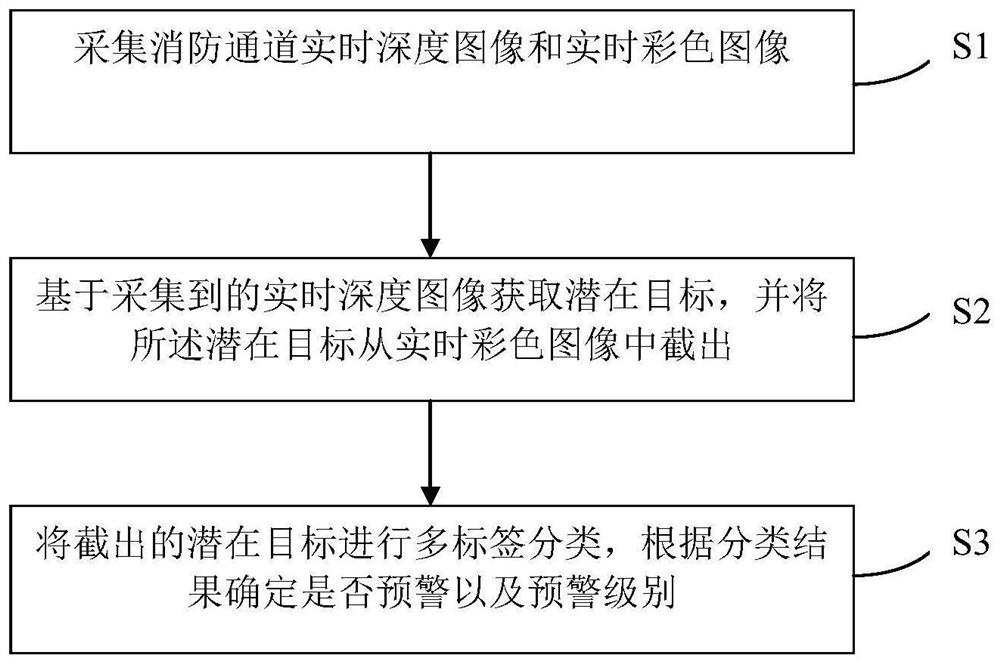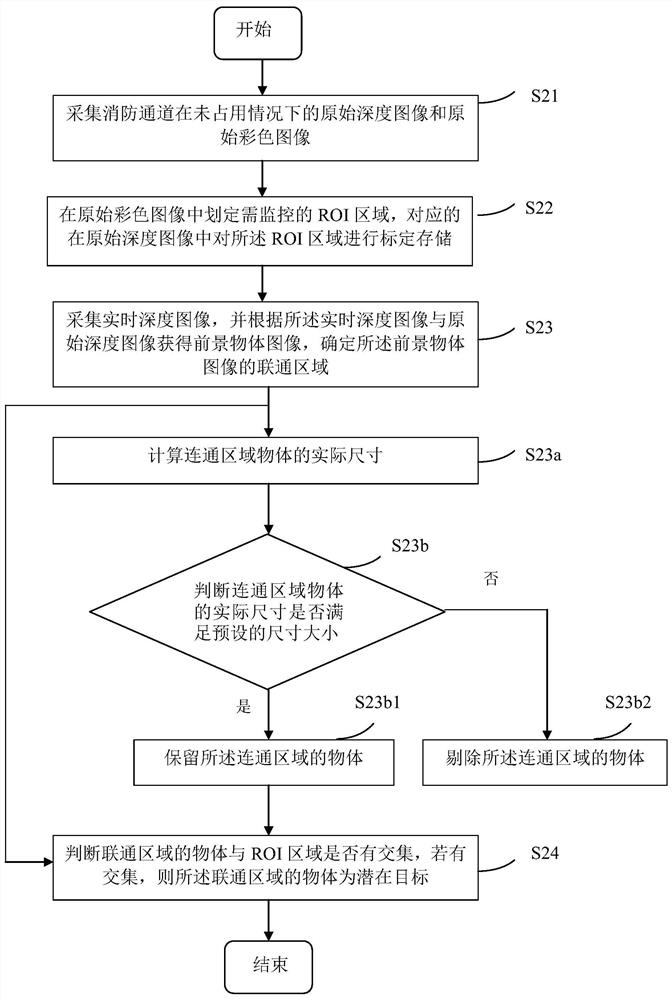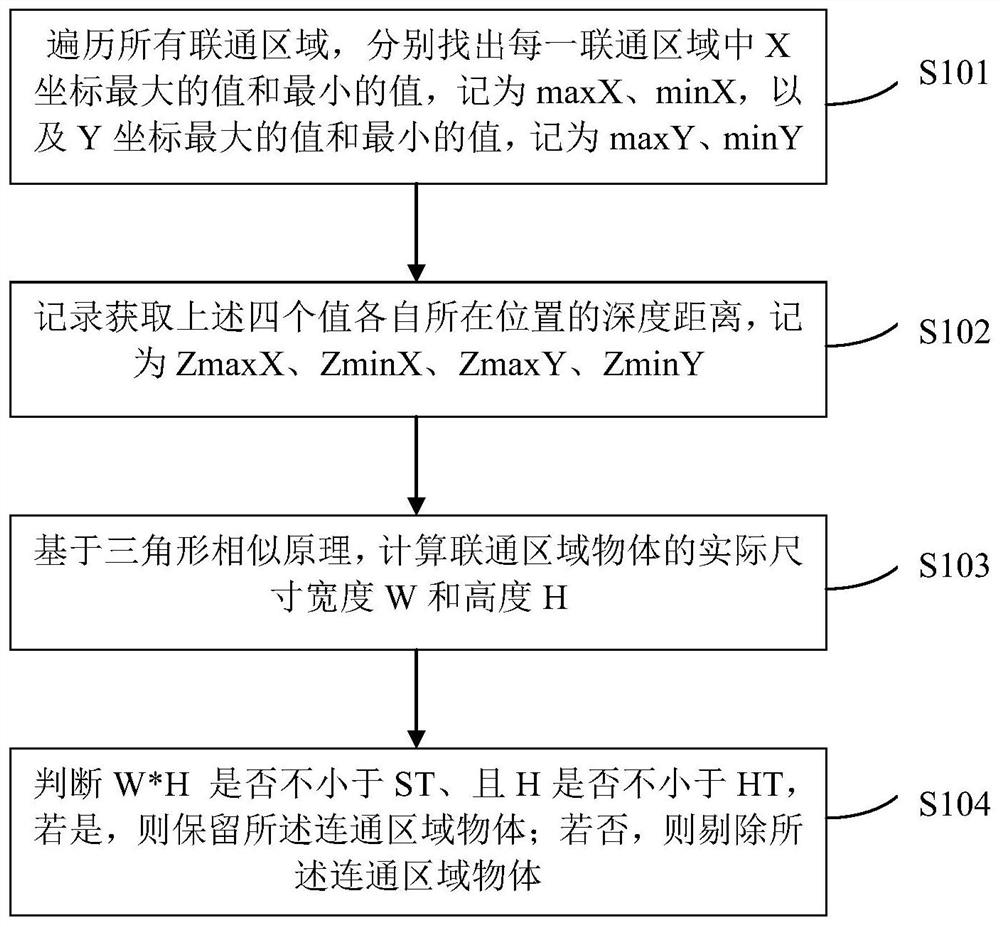Fire fighting access occupation detection method and system based on depth information
A technology of fire exit and detection method, applied in data processing applications, instruments, character and pattern recognition, etc., can solve the problems of large error in abnormal target size, low accuracy, false alarm, etc., to avoid false alarm problems and reduce leakage. The effect of detecting problems and reducing the false negative rate
- Summary
- Abstract
- Description
- Claims
- Application Information
AI Technical Summary
Problems solved by technology
Method used
Image
Examples
Embodiment 1
[0073] Such as figure 1 As shown, this embodiment discloses a method for detecting the occupancy of fire exits based on depth information, including the following steps:
[0074] S1: Collect real-time depth images and real-time color images of fire exits;
[0075] S2: Acquiring potential targets based on the collected real-time depth image, and cutting out the potential targets from the real-time color image;
[0076] S3: Perform multi-label classification on the intercepted potential targets, and determine whether to warn and the level of warning according to the classification results.
[0077] The fire exit occupancy detection method based on depth information provided by this embodiment obtains potential targets by fusing depth information, effectively avoids false alarms caused by two-dimensional perspective transformation, and effectively solves the problem that traditional detection methods cannot detect all Objects occupying indoor fire exits are detected, and the ac...
Embodiment 2
[0151] This embodiment provides a fire exit occupancy detection system based on depth information. The system includes an image acquisition unit, a processor, and a memory, wherein the processor implements the above embodiments when executing the computer program stored in the memory. A fire exit occupancy detection method.
[0152] In the above solution, the image acquisition unit includes a camera or a camera capable of acquiring real-time depth images and real-time color images of fire exits in real time.
[0153] Preferably, the image acquisition unit includes: an RGBD camera installed in the fire escape, used to collect real-time depth images and real-time color images of the fire escape, so as to monitor whether the fire escape is occupied.
[0154] In this embodiment, the RGBD camera is used as the image acquisition unit. Compared with using two cameras to acquire the color image and the depth image respectively, the acquisition of the depth image and the color image ca...
Embodiment 3
[0157] This embodiment also provides a computer-readable storage medium, where instructions are stored on the computer-readable storage medium, and when the instructions are executed by the processor, the method for detecting the occupancy of fire exits based on depth information in the first embodiment above is implemented step.
[0158] For example, when the processor executes the computer program, the following steps are implemented:
[0159] S1: Collect real-time depth images and real-time color images of fire exits;
[0160] S2: Acquiring potential targets based on the collected real-time depth image, and cutting out the potential targets from the real-time color image;
[0161] S3: Perform multi-label classification on the intercepted potential targets, and determine whether to warn and the level of warning according to the classification results.
[0162] In addition, the above logic instructions in the memory can be implemented in the form of software functional unit...
PUM
 Login to View More
Login to View More Abstract
Description
Claims
Application Information
 Login to View More
Login to View More - R&D
- Intellectual Property
- Life Sciences
- Materials
- Tech Scout
- Unparalleled Data Quality
- Higher Quality Content
- 60% Fewer Hallucinations
Browse by: Latest US Patents, China's latest patents, Technical Efficacy Thesaurus, Application Domain, Technology Topic, Popular Technical Reports.
© 2025 PatSnap. All rights reserved.Legal|Privacy policy|Modern Slavery Act Transparency Statement|Sitemap|About US| Contact US: help@patsnap.com



